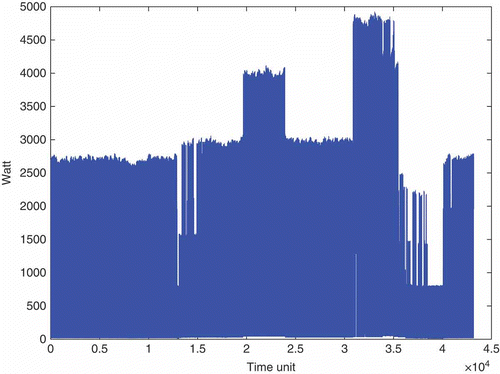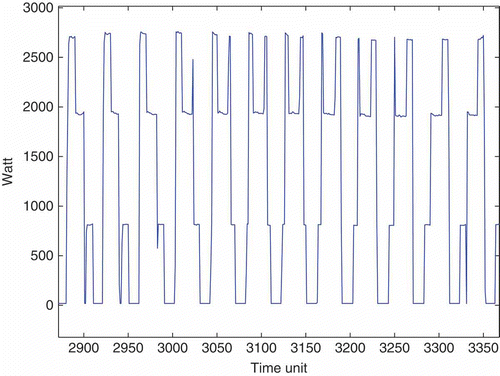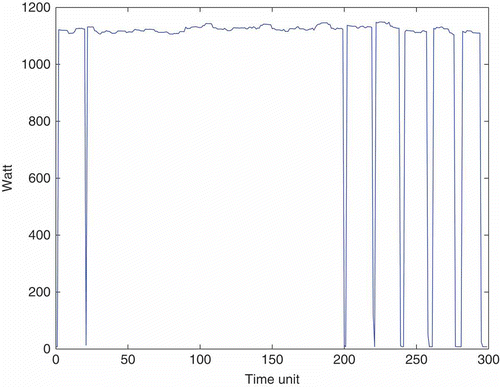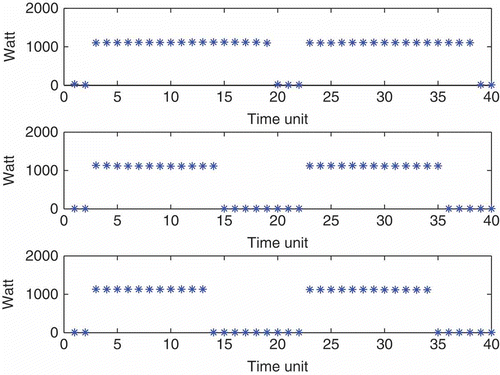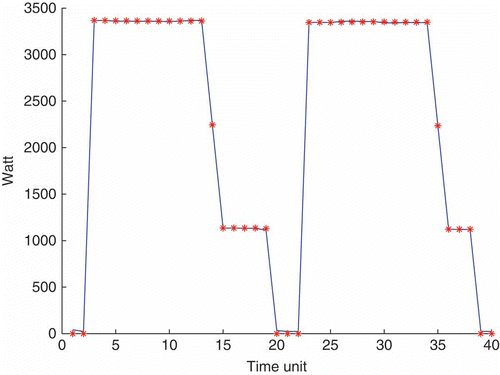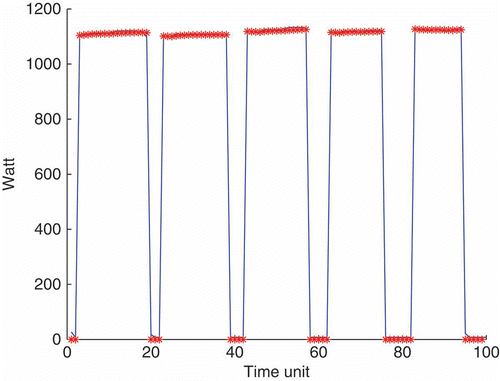Abstract
We wish to compute in discrete real time the best estimate for the composition of the total active power recorded at a customer's house, without any intrusion. A new solution for online characterization of the electric load is proposed. The solution is based on issues from the applied stochastic analysis of Markov processes. We specifically suggest that optimal filtering of a hybrid stochastic differential system covers entirely the detection and separation subproblems underlying the main problem.
1. Introduction
Saving energy is a challenge for the industry and the consumers of electricity for economic and environmental reasons. Compiling electric load data turns consumers' variable electric appliances and habits from a source of confusion to a source of knowledge. This is what the experts call electric load monitoring, namely, using the electricity meter. This tool is a centralized and accessible part of a distribution network. We are primarily concerned here with understanding the electric load by separating (or isolating) its major components; their number is of course unknown since it is random and varying in time. In principle, such a problem is dealt with as two subproblems: (1) detection – estimating the number of components; and (2) decomposition – estimating the bearings of those components. Here we shall not make this distinction; we address at one go these two problems. Our approach is to formulate the basic problem as filtering a hybrid stochastic differential system.
The literature on source detection and separation is extensive; see, for example, the book by Johnson and Dudgeon [Citation1]. This leads us to a general classification of possible methods into two categories depending on whether the number of sources is known a priori. In any case, the number of sources is determinate and fixed during the observation. Regarding the application, among the basic references concerning electric load monitoring are [Citation2–4], but the work by El Guedri [Citation5] is our key source reference. Her algorithm in [Citation6], for instance, is based on the interpretation of the convector signature in the time-frequency domain. It appears, however, that again the unknown number of convectors is assumed to be fixed throughout the experimental tests. It may be more realistic to regard this number depending on time as random variable. Indeed, this is precisely the discrete component of our hybrid stochastic differential system.
The treatment here, and in the references mentioned above, is focused on space heating by convectors since it is the most consuming appliance. The active power sample path of a heating load for 1 day is plotted in ; is a zoom in this plot. Certain assumptions must be made about the underlying signals; to this end, an example of a signal generated by one convector is shown in . This plot reveals, for instance, a time variation of the width of squares due to a saturation of the convector. For this argument, we assume that the observed signal is a sum of a time-varying random number – which may be null – of possibly overlapping squares. It is worth noting that a square amplitude may be the same even if it corresponds to different convectors. Besides, a synchronism between two convectors is frequent: the start up of a square and the shutdown of another occur at the same time. All these aspects are taken into account by the following model and shall not be sources of complexity anymore.
Let yt be the number of squares at time t and xt the vector of amplitudes of these squares. In other words, when yt ≠ 0, it represents the dimension of xt . Moreover, as long as yt = 0, xt = 0. A sample path of yt is thus a step function assuming values in a finite discrete set, say {0,1,2,3}. Here, this means that there must not be more than three convectors that are simultaneously on at any time. Let t = 0 on starting the observation of any heating load. The observation zt is the sum of the components of xt if yt ≠ 0, that is,
But as long as yt = 0, the observation zt is null. Finally, we assume that at t = 0, y 0 = 0 and thus x 0 = 0, z 0 = 0.
Section 2 is devoted to the development of a model for the unobservable, or latent, signal (xt , yt ): a piecewise deterministic process (PDP). The ingredients of the PDP – such as the state space, the vector field – are then identified from real data. Thus, characterizing the electric heating load is nothing but filtering the PDP (xt , yt ) from the observable process zt . Of interest are a couple of operators associated to any Markov process: the generating operator and the Fokker–Planck operator. Section 3 consists of the computation of these bearings for our signal model, the PDP (xt , yt ). Section 4 contains the filtering equations and a demonstration on real data provided by Électricité de France.
2. A hybrid stochastic differential system: PDP
A piecewise deterministic process is one particular determinate motion that starts afresh between random jumps of two kinds, spontaneous or predictable. Jumping has two ingredients: a hazard rate for spontaneous jumps and a probability distribution to reinitiate the motion after every jump, of both types. This results in a strong Markov càdlàg stochastic process. PDP has widely been used since Davis introduced it in 1984; the reference [Citation7] is our main tool on the subject.
State space E: The state space of a PDP is a disjoint union of some manifolds with boundary.
Thus, a PDP is denoted as (xt
, yt
) or ξ
t
with ; yt
is a Y-valued continuous-time process and xt
is a continuous-time process with values in My
as long as yt
= y × yt
is assumed as the discrete component of the state and xt
its continuous component.
Remark. As a Markov process, ξ
t
is based on some filtered probability space . Customarily, a family
of probability measures on
is defined by
By construction
Under the original probability measure IP, ξ
t
starts at t = 0 with μ, a probability distribution on , where
is the Borel σ-algebra of E. For the simple reason that
Vector field Φ: One particular vector field determines the motion between the jumps. Denote the first jump time of ξ t as T 1. Then
Jumping rate λ: T 1 is a random variable with the following probability distribution:
Active boundary Γ: Starting from any interior point, everywhere a PDP reaches the boundary ∂E it jumps instantaneously. Thus, the active or essential boundary of the state space is the set of boundary points almost surely reachable by the process (within a predictable stopping time). This is also written as: the active boundary Γ is a set of boundary points of the state space such that
Markovian kernel Q: It states the conditional probability distribution on E of the post-jump state ξ(T 1) given the conditioning event
Further into the application
Let us finish the modelling that we have began in the introduction by identifying the ingredients of our PDP. Here there are four regimes or modes labelled by the number of squares, that is,
As long as yt
= 1, xt
is the square amplitude taking values in and solving
The square magnitudes A min, A max are the lower and upper bounds of the nominal power for any convector; these are known from real data [Citation5]:
As long as yt
= 2, xt
takes values in and solves
The same reasoning holds for the fourth regime, as and when yt = 3. Thus, the vector field within the non-degenerate modes (modes 1,2 and 3) is null,
It is clear that the state space is given by
Jumping between the regimes or within one and the same regime is done in the following way:
| • | From mode 0, a jump goes to modes 1, 2 or 3, with the same probability of 1/3 each. Furthermore, we assume a jumping rate λ0 constant over time. | ||||
| • | There may be jumps of our PDP within mode 1 – these are jumps of its continuous component – or jumps from mode 1 to modes 0, 2 or 3. We assume the same probability of 1/4 for each kind of jumps, and a constant jumping rate λ1. | ||||
| • | The reasoning for mode 1 applies to modes 2 and 3 with jumping rates λ2 and λ3, respectively. | ||||
As to the Markovian kernel, we make this choice: the process ξ t is reinitiated according to a uniform distribution after every jump to a non-degenerate mode, that is, for any (x, y) ∈ E
Note the independence from the pre-jump state ξ = (x, y). Obviously, for jumps to mode 0, we have for any
3. The generating operator and the Fokker–Planck operator for the signal model
The above description yields, in the first place, to the generating operator of our signal model, the PDP ξ
t
. Let f be a measurable function
and we claim that
For x ∈ M 1,
For x ∈ M 2,
For x ∈ M 3,
There are no imposed conditions on – the domain of
– at the boundary of the state space since this boundary is never reached.
Now we are ready to write Dynkin's formula for the signal process ξ t . Dynkin's formula is the main tool in computing expectations for a wide class of functions:
provided that f is bounded and the mean number of entering/exiting squares per finite time interval is finite [Citation8]; this holds quite naturally in our application.
In the second place, the central concept of this section is the Fokker–Planck operator along with its domain
. It is the adjoint of the generating operator in the sense that, for
and
,
The pairing of and p, regarded as a function of x, denotes
Note that to write the relations above, we need to assume the existence of a density p(t, x, y) or p(t, ξ) for the distribution on , under IP, of
. That is, for y ∈ Y, y ≠ 0, and Λ a Borel-measurable set from My
We claim that for x ∈ M 1,
For x ∈ M 2,
For x ∈ M 3,
Assuming that for each and each y ∈ Y, y ≠ 0,
possesses a density with respect to the Lebesgue measure on My
, written
Thus, for x ∈ M 1,
For x ∈ M 2,
For x ∈ M 3,
Finally, we claim that
Regarding , it is the set of functions
satisfying for each
Furthermore, there are no imposed conditions on p – so as to belong to – at the boundary of the state space since this boundary is never reached by the process ξ
t
.
Now if we assume that
we obtain
The assumption (EquationEquation (2)(2)) is not an artefact to simplify the calculus; it says that we do not have any reason to attest that all the kinds of jumps do not have the same rate or intensity. A straightforward calculation based on real data shows that
Finally, the distribution density of ξ
t
solves the Fokker–Planck Equationequation [9](9):
The solution of the Fokker–Planck equation above is given by
4. Filtering
Now we consider the filtering problem associated to the couple (ξ
t
, zt
). We have non-linear observations of ξ
t
, the discrete-time process (zn
)
n = 1, 2, … indexed at irregularly spaced instants t
1, t
2, …; these are deterministic and known. The observations are related to the state process via the conditional distribution
It appears clearly now that the perturbation is also done so as to avoid the Dirac measure when expressing the conditional distribution in the filtering equations; see EquationEquations (10)
(10) and Equation(11)
(11).
4.1. Conditional density characterization: the optimal filter
The best estimate – in a sense of the mean square – of f(ξ
t
) given the observations up to time t is the conditional expectation
For homogeneity of notation, we set
Now recall the Fokker–Planck operator of ξ
t
developed in Section 3; it follows that the posterior distribution density for tn
–1 ≤ t < tn
, n ≥ 1, solves the Fokker–Planck equation
Here analytic resolution of EquationEquations (3(3)
Equation–4
(4)) is computationally tractable. The solution is Equation5–8) below:
On the other hand, at each observation instant tn
, n ≥ 1, solves the Bayes rule
Obviously, the initialization of the optimal filter is given by
The symbol ∝ in EquationEquation (9)(9) means up to a normalization constant. This constant is computed by imposing the following condition at each observation time tn
, n ≥ 1:
Then looking at Equation5–8), one can easily see that the condition
4.2. Implementation result
A run on a synthetic mixture is displayed in ; shows the true mixture components. The observed signal which is the filter input is, of course, the sum of these components, and is useful as a reference. At each observation time the set of stars is the a posteriori maximum estimate of the state , n ≥ 1. Note the accuracy of the decomposition: the number of squares is recovered and the magnitudes of these squares are quite well estimated. is to check if the summation (stars) of the component magnitudes coincide with the observation (full line). A second run on another scenario is displayed in where we plot the reference (full line), which is also the observed signal, and the estimate (stars).
5. Conclusion and future work
Probabilistic management of uncertainty in dynamical systems is addressed with application in electric load monitoring. We sum up the contribution of this article by: a non-intrusive method for characterizing the space heating. This is based on modelling the underlying signals as a hybrid stochastic differential system. Thus the characterization is reformulated as a filtering problem. The optimal filter is computed and then implemented with real scenarios. Comparisons are made, and the apparent usefulness of the method is assessed. It must be borne in mind, however, that optimal filtering is possible only if the analytic resolution of the Fokker–Planck equation is feasible. It should be emphasized that whereas the treatment here is based on the interpretation of the convector signature – a square – in the time domain, our method has wider applicability. On the one hand, it extends to more general problems of source detection and separation; and on the other, it applies to other electric appliances. In this connection, another appliance may have a different signature but leads us again to a vector field which is then not null and, of course, the same for all the non-degenerate modes.
References
- Johnson , D.H. and Dudgeon , D.E. 1993 . Array Signal Processing: Concepts and Techniques , Englewood Cliffs, NJ : Prentice-Hall .
- Hart , G. 1989 . Residential energy monitoring and computerized surveillance via utility power flows . IEEE Technol. Soc. , 8 ( 2 ) : 12 – 16 .
- Laughman , C. , Lee , K. , Cox , R. , Shaw , S. , Norford , L. and Armstrong , P. 2003 . Power signature analysis . IEEE Power and Energy Mag. , 1 ( 2 ) : 55 – 63 .
- Leeb , S. 1993 . A conjoint pattern recognition approach to non-intrusive load monitoring , Ph.D. diss., Massachusetts Institute of Technology .
- El Guedri , M. 2009 . Caractérisation aveugle de la courbe de charge électrique: détection, classification et estimation des usages dans les secteurs résidentiel et tertiaire , Ph.D. diss., Université Paris Sud IX .
- El Guedri , M. Time frequency characterization for electric load monitoring . 17th European Signal Processing Conference . Glasgow, Scotland. CD-ROM Proceedings, 08/09 .
- Davis , M.H.A. 1993 . Markov Models and Optimization , London : Chapman & Hall .
- Baili , H. 2011 . Stochastic analysis of noncompliance with drug therapy . J. Uncertain. Syst. , 5 : 38 – 44 .
- Gardiner , C.W. 1985 . Handbook of Stochastic Methods for Physics, Chemistry and the Natural Sciences , 2nd , Berlin : Springer-Verlag .
